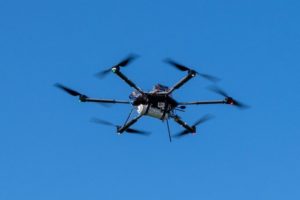
British clean-tech firm H2GO Power has partnered with Ballard Unmanned Systems in what may be the first-ever test flight of a 3D-printed, hydrogen-powered drone.
According to an H2GO Power media release, the flight launched in late August from a test site in Boston.
Several tech firms have soared into hydrogen-fuel research as the next generation in drone power systems. However, H2GO seems to be the first to boast a 3D-printed rotor UAV.
Hydrogen fuel has been shown maximize drone flight time with a cleaner energy footprint (check out 8 Reasons Why Hydrogen Will Power the Drone Industry’s Future).
“The company’s drone application solution can increase the flight time of a drone’s battery by up to 90 minutes, compared with less than 25 minutes for typical lithium-ion battery systems,” an H2GO Power spokesperson said.
“The cutting-edge design allows for up to 15 percent of total drone weight reduction and volume control – achieved by the 3D printed lightweight metal – as well as creating internal structures that optimize heat management into and out of the power system. This enables UAVs to travel three to five times further and carry heavier payloads.”
“This is a hugely exciting development for our unique technology and brings us a step closer to delivering clean and sustainable energy delivery,” H2GO Power CEO Enass Abo-Hamed said:
Abo-Hamed added the company’s power system creates a safer process as well as “lightweight, scalable, clean energy storage that creates significant cost savings and is up to five times more efficient than existing alternatives.”
In addition, Estonian drone manufacturer SKYCORP has doubled the maximum flight time of its hydrogen-powered e-Drone Zero. The commercial drone can fly for two hours thanks to its ultra-lightweight gas cylinder from AMS Composite Cylinders.
Over the past 24 months, Intelligent Energy has launched four fuel-facing products for commercial drone tech. The company’s 800W Fuel Cell Power Module set a Guinness World Record for the longest multi-rotor flight time – 12 hours, 7 minutes and 5 seconds using liquid hydrogen.
Jason is a longstanding contributor to DroneLife with an avid interest in all things tech. He focuses on anti-drone technologies and the public safety sector; police, fire, and search and rescue.
Beginning his career as a journalist in 1996, Jason has since written and edited thousands of engaging news articles, blog posts, press releases and online content.
Email Jason
TWITTER:@JasonPReagan
Subscribe to DroneLife here.